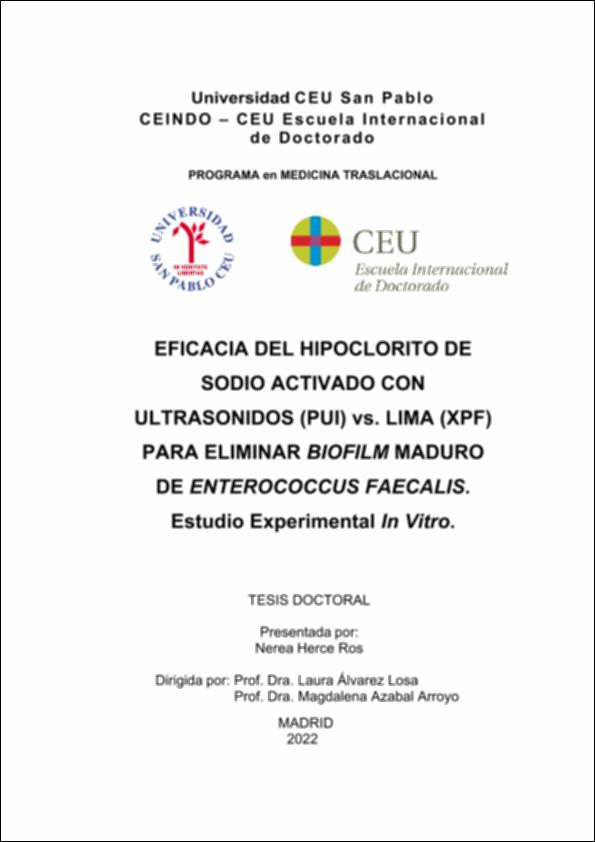Please use this identifier to cite or link to this item:
http://hdl.handle.net/10637/13821Eficacia del hipoclorito de sodio activado con ultrasonidos (PUI) vs. lima (XPF) para eliminar biofilm maduro de enterococcus faecalis : estudio experimental in vitro.
| Title: | Eficacia del hipoclorito de sodio activado con ultrasonidos (PUI) vs. lima (XPF) para eliminar biofilm maduro de enterococcus faecalis : estudio experimental in vitro. |
| Authors : | Herce Ros, Nerea |
| Keywords: | Hipoclorito de sodio (NaOCl); biofilm; Enterococcus faecalis; Irrigación Pasiva Ultrasónica (PUI); lima XP-endo®; Finisher (XPF); Sodium hypochlorite (NaOCl); Passive Ultrasonic Irrigation (PUI); XP-endo®; Finisher (XPF) file |
| Abstract: | Durante la endodoncia se utilizan tanto limas (manuales y rotatorias), como agentes
irrigantes. Dada la complejidad de la anatomía interna del sistema de conductos
radiculares es necesario recurrir a la activación de los irrigantes para impulsarlos y
que puedan acceder a todas las zonas del conducto.
En esta investigación se ha evaluado la eficacia de dos concentraciones de NaOCl
(2,5% y 5,25%) activado mediante dos técnicas (PUI vs. lima XPF) para eliminar
biofilm maduro de Enterococcus faecalis del conducto radicular.
Tras la instrumentación de los conductos, 66 raíces unirradiculares humanas fueron
inoculadas con Enterococcus faecalis y se dejaron incubando en una estufa a 37ºC
durante 2 semanas. Tras los tratamientos en los distintos grupos experimentales, se
observó que el NaOCl resultó eficaz en la eliminación de biofilm maduro de E.faecalis
en todos los grupos (p <0,05) y que precalentando el NaOCl 5,25% a temperatura
corporal (37ºC) y activándolo con la lima XPF se obtenía una eficacia similar a la
obtenida con la misma concentración de NaOCl a temperatura ambiente activado
con PUI. Por lo tanto, se puede concluir que la lima XPF solo es capaz de alcanzar
la eficacia del PUI cuando se precalienta el NaOCl. During root canal treatment, we use both files (manual and rotary) and irrigating agents. Given the complexity of the internal anatomy of the root canal system, it is necessary to resort to the activation of the irrigants to boost them so that they can access all the areas of the canal. In this research, the efficacy of two concentrations of NaOCl (2.5% and 5.25%) activated by two techniques (PUI vs. XPF file) to remove mature biofilm of Enterococcus faecalis from the root canal has been evaluated. After canal instrumentation, 66 human single-rooted roots were inoculated with Enterococcus faecalis and incubated in an oven at 37°C for 2 weeks. After the treatments in the different experimental groups, it was observed that NaOCl was effective in the elimination of mature biofilm of E.faecalis in all groups (p <0.05) and that preheating NaOCl 5.25% at body temperature (37ºC) and activating it with the XPF file, an efficiency similar to that obtained with the same concentration of NaOCl at room temperature activated with PUI was obtained. Therefore, it can be concluded that the XPF file is only able to reach the efficacy of the PUI when NaOCl is preheated. |
| Description: | Tesis-CEINDO, Universidad San Pablo CEU, Programa en Medicina Traslacional, leida el 29 de junio de 2022 |
| Director(s): | Azabal Arroyo, Magdalena Álvarez Losa, Laura |
| URI: | http://hdl.handle.net/10637/13821 |
| Rights : | http://creativecommons.org/licenses/by-nc-nd/4.0/deed.es |
| Issue Date: | 4-Aug-2022 |
| Center : | Universidad San Pablo-CEU |
| Appears in Collections: | Medicina Traslacional |
Items in DSpace are protected by copyright, with all rights reserved, unless otherwise indicated.


